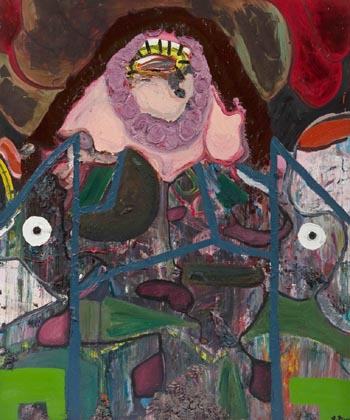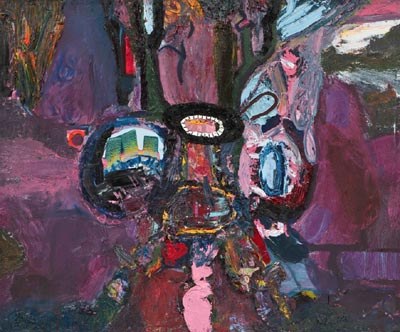A recent graduate of UCLA’s renowned MFA program, Ian Pines continues to explore the  wickedly inventive color work and lavishly gestural oil paintings he began while still an art major at UCSC. Here’s a sample of Pines’ highly original abstract style, played out in large-scale (e.g. 6 x 8 foot) canvases, and a brief interview with the Los Angeles-based artist.
wickedly inventive color work and lavishly gestural oil paintings he began while still an art major at UCSC. Here’s a sample of Pines’ highly original abstract style, played out in large-scale (e.g. 6 x 8 foot) canvases, and a brief interview with the Los Angeles-based artist.
Q: Ian—your abstract paintings remind me of Philip Guston by way of Willem de Kooning. Are you aware of any particular influences in your style?
A: That’s quite the apt observation. Like de Kooning, there are bombastic color choices forcefully yet thoughtfully laid on top of each other to make homely, sad, and whimsical forms similar to Guston’s.
Francis Bacon’s witty horror, stylized violence, and macabre non-sequiturs have always been my favorite. The immediacy of his work is something I strive for. I compare my work with the COBRA movement’s (based in Copenhagen, Brussels, Amsterdam which included such artists as Karel Appel and Asger Jorn) uses of abstract expressionism in the construction of figurative forms. I am also influenced by Carroll Dunham’s work, especially of the 1990s, which places teeth and genitalia on abstract forms in order to dramatically and instantaneously anthropomorphize them. Eyes and teeth added to my compositions significantly help unify my paintings and give them a more contemporary twist.
Q: How did your MFA work at UCLA help you develop your creative instincts?
A: UCLA nurtured my creativity by channeling it into a certain rhythm and regimentation that develops a whole painting which resonates up close and from far away, not just with me but with others. I now more fully imagine stepping outside of  myself after painting furiously and see how it looks from afar, from a perspective of one who has just entered the room. In addition, my very intuitive color combinations have become more acute than in the past. Finally, my patience with the creative process has improved: I now allow a work to develop over a longer period of time.
myself after painting furiously and see how it looks from afar, from a perspective of one who has just entered the room. In addition, my very intuitive color combinations have become more acute than in the past. Finally, my patience with the creative process has improved: I now allow a work to develop over a longer period of time.
Q: Can you describe the process involved in making one of these large-scale paintings?
A: Most of the large-scale paintings take months to craft—three to four months a painting, with three to four at a time. They typically start out with a number of expansive, quick, and improvised marks with a brush or oil pastel, or with a monochromatic underpainting. (In the past, a simple cosmological chart of my own sometimes took place of these dashes or color fields.) I then typically accentuate the marks or surface with bright and jarring color combinations, thick/forceful brushstrokes, and awkward forms that resonate with a viewer immediately. Attempting to organize such conspicuous and expressionistic gestures in a prolonged improvisational fashion results in a compounding of second-guesses  wrought with frustration at the collapse of control, yet something gestates in the chaos and confusion. The piled-on inconsistencies along with the privileging and repeating of idiosyncrasy and novelty result in unanticipated new forms that spring forth from the muddled myriad of coalescing marks. These collective structures are typically not as engrossing as their disparate elements and require endless refinement; however, they do spur me to labor over the painting in search of a balanced formation. This process results in a highly formal and vague narrative that develops with the work and references my previous paintings. Occasionally, an essential last-ditch effort in the form of a violent adjustment that sweeps over nearly the entire canvas (possibly a scraping down and/or broad application of color) forges one or two forms that are highly integrated with the painting—a superstructure that bluntly binds the work in a considerable dynamism. Crag (first image at top) is an excellent example of such a procedure.
wrought with frustration at the collapse of control, yet something gestates in the chaos and confusion. The piled-on inconsistencies along with the privileging and repeating of idiosyncrasy and novelty result in unanticipated new forms that spring forth from the muddled myriad of coalescing marks. These collective structures are typically not as engrossing as their disparate elements and require endless refinement; however, they do spur me to labor over the painting in search of a balanced formation. This process results in a highly formal and vague narrative that develops with the work and references my previous paintings. Occasionally, an essential last-ditch effort in the form of a violent adjustment that sweeps over nearly the entire canvas (possibly a scraping down and/or broad application of color) forges one or two forms that are highly integrated with the painting—a superstructure that bluntly binds the work in a considerable dynamism. Crag (first image at top) is an excellent example of such a procedure.
Lately though, a fair amount of my works have started out with a new style of using an amalgam of dried paint scrapings mixed in with Galkyd (an alkyd resin) and spread over a typically black surface, resulting in a celestial look to the painting. Sometimes this becomes the underpainting as in The Vault of Heaven (above, horizontal).
Q: Did you always make art?
A: Somewhat. When I was a child I drew, made characters and stories about them. I was really into science, astronomy, cosmology, cybernetics, particle physics, or at least what I what I took those sciences to be. I now think that I actually liked the aesthetics of the theories, the shape of the theories—the appearance, physical manifestations, possibilities, and emotions of them—as opposed the analytical processes by which they are developed.
Q: Are you consciously working against the digital tide?
 A: I’d say I’m doing so by working in an ancient, analog medium steeped in history. A painting is handmade, one-of-a kind, and unique, something fairly rare nowadays with easily copied and dispersed information and items by means of computers/ telecommunication/machines/assembly lines, etc. My work used to loosely illustrate this digital, exponentially increasing techno craziness and how I felt it fit into a history/ narrative/cosmology/mythology of the universe. But now my work is more elemental: more about the phenomenology of paint itself.
A: I’d say I’m doing so by working in an ancient, analog medium steeped in history. A painting is handmade, one-of-a kind, and unique, something fairly rare nowadays with easily copied and dispersed information and items by means of computers/ telecommunication/machines/assembly lines, etc. My work used to loosely illustrate this digital, exponentially increasing techno craziness and how I felt it fit into a history/ narrative/cosmology/mythology of the universe. But now my work is more elemental: more about the phenomenology of paint itself.
Q: What do you do in your “spare time?†or is it always painting?
A:Â I do paint a lot; however, I also enjoy backpacking, museums, running, family, old friends, reading, writing, and watching films.
Â


” the wickedly inventive color work” ???
This is Kitsch, pure and simple.
You degrade us by elevating it to “art”.